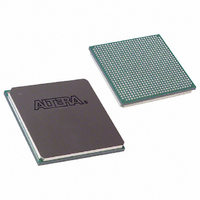EP1S20F780I6N Altera, EP1S20F780I6N Datasheet - Page 609

EP1S20F780I6N
Manufacturer Part Number
EP1S20F780I6N
Description
IC STRATIX FPGA 20K LE 780-FBGA
Manufacturer
Altera
Series
Stratix®r
Specifications of EP1S20F780I6N
Number Of Logic Elements/cells
18460
Number Of Labs/clbs
1846
Total Ram Bits
1669248
Number Of I /o
586
Voltage - Supply
1.425 V ~ 1.575 V
Mounting Type
Surface Mount
Operating Temperature
-40°C ~ 100°C
Package / Case
780-FBGA
Family Name
Stratix
Number Of Logic Blocks/elements
18460
# I/os (max)
586
Frequency (max)
450.05MHz
Process Technology
0.13um (CMOS)
Operating Supply Voltage (typ)
1.5V
Logic Cells
18460
Ram Bits
1669248
Operating Supply Voltage (min)
1.425V
Operating Supply Voltage (max)
1.575V
Operating Temp Range
-40C to 100C
Operating Temperature Classification
Industrial
Mounting
Surface Mount
Pin Count
780
Package Type
FC-FBGA
Lead Free Status / RoHS Status
Lead free / RoHS Compliant
Number Of Gates
-
Lead Free Status / Rohs Status
Compliant
Available stocks
Company
Part Number
Manufacturer
Quantity
Price
Company:
Part Number:
EP1S20F780I6N
Manufacturer:
ALTERA
Quantity:
3 000
- Current page: 609 of 864
- Download datasheet (11Mb)
Altera Corporation
September 2004
Implementing High Performance DSP Functions in Stratix & Stratix GX Devices
Polyphase Decimation Filter Implementation Results
Table 7–14
implementation in a Stratix device shown in
Polyphase Decimation Filter Design Example
Download the Decimation FIR Filter (decimation_fir.zip) design
example from the Design Examples section of the Altera web site at
www.altera.com.
Complex FIR Filter
A complex FIR filter takes real and imaginary input signals and performs
the filtering operation with real and imaginary filter coefficients. The
output also consists of real and imaginary signals. Therefore, a complex
FIR filter is similar to a regular FIR filter except for the fact that the input,
output, and coefficients are all complex numbers.
One example application of complex FIR filters is equalization. Consider
a Phase Shift Keying (PSK) system; a single complex channel can
represent the I and Q data channels. A FIR filter with complex coefficients
could then process both data channels simultaneously. The filter
coefficients are chosen in order to reverse the effects of intersymbol
interference (ISI) inherent in practical communication channels. This
operation is called equalization. Often, the filter is adaptive, i.e. the filter
coefficients can be varied as desired, to optimize performance with
varying channel characteristics.
A complex variable FIR filter is a cascade of complex multiplications
followed by a complex addition.
representation of a complex FIR filter. To compute the overall output of
the FIR filter, it is first necessary to determine the output of each complex
multiplier. This can be expressed as:
Note to
(1)
Part
Utilization
Performance
Table 7–14. Polyphase Decimation Filter Implementation Results
This refers to the performance of the DSP blocks, as well as the input clock rate.
The output rate is 60 MSPS (clocked out at 60MHz).
Table
shows the results of the polyphase decimation filter
7–14:
EP1S10F780
Lcell: 168/10570 (1%)
DSP Block 9-bit elements: 8/48 (17%)
Memory bits: 300/920448(<1%)
240 MHz
(1)
Figure 7–18
Stratix Device Handbook, Volume 2
Figure
shows a block diagram
7–17.
7–31
Related parts for EP1S20F780I6N
Image
Part Number
Description
Manufacturer
Datasheet
Request
R

Part Number:
Description:
CYCLONE II STARTER KIT EP2C20N
Manufacturer:
Altera
Datasheet:

Part Number:
Description:
CPLD, EP610 Family, ECMOS Process, 300 Gates, 16 Macro Cells, 16 Reg., 16 User I/Os, 5V Supply, 35 Speed Grade, 24DIP
Manufacturer:
Altera Corporation
Datasheet:

Part Number:
Description:
CPLD, EP610 Family, ECMOS Process, 300 Gates, 16 Macro Cells, 16 Reg., 16 User I/Os, 5V Supply, 15 Speed Grade, 24DIP
Manufacturer:
Altera Corporation
Datasheet:

Part Number:
Description:
Manufacturer:
Altera Corporation
Datasheet:

Part Number:
Description:
CPLD, EP610 Family, ECMOS Process, 300 Gates, 16 Macro Cells, 16 Reg., 16 User I/Os, 5V Supply, 30 Speed Grade, 24DIP
Manufacturer:
Altera Corporation
Datasheet:

Part Number:
Description:
High-performance, low-power erasable programmable logic devices with 8 macrocells, 10ns
Manufacturer:
Altera Corporation
Datasheet:

Part Number:
Description:
High-performance, low-power erasable programmable logic devices with 8 macrocells, 7ns
Manufacturer:
Altera Corporation
Datasheet:

Part Number:
Description:
Classic EPLD
Manufacturer:
Altera Corporation
Datasheet:

Part Number:
Description:
High-performance, low-power erasable programmable logic devices with 8 macrocells, 10ns
Manufacturer:
Altera Corporation
Datasheet:

Part Number:
Description:
Manufacturer:
Altera Corporation
Datasheet:

Part Number:
Description:
Manufacturer:
Altera Corporation
Datasheet:

Part Number:
Description:
Manufacturer:
Altera Corporation
Datasheet:

Part Number:
Description:
CPLD, EP610 Family, ECMOS Process, 300 Gates, 16 Macro Cells, 16 Reg., 16 User I/Os, 5V Supply, 25 Speed Grade, 24DIP
Manufacturer:
Altera Corporation
Datasheet:












